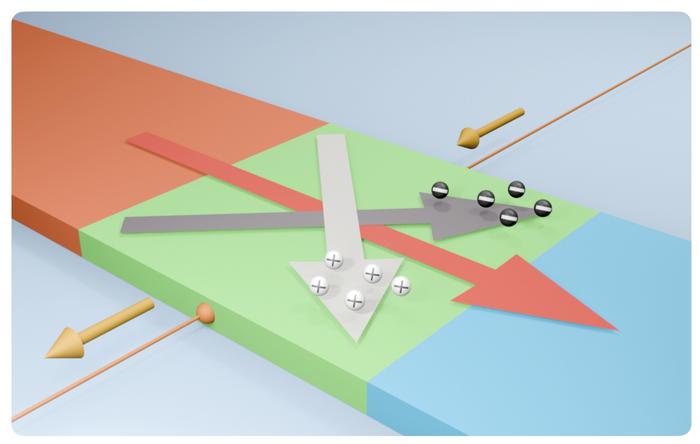Researchers from the Tokyo University of Science have successfully demonstrated a novel method for converting waste heat into usable electricity using tungsten disilicide (WSi2). This landmark discovery, published in PRX Energy on November 13, 2024, represents a significant advancement in thermoelectric technology and could transform how we harness waste energy in everything from industrial processes to satellite systems.
The research team, led by Associate Professor Ryuji Okazaki from the Department of Physics and Astronomy, has unveiled the first direct demonstration of transverse thermoelectric generation in tungsten disilicide, marking a crucial milestone in the field of clean energy conversion. Their innovative approach tackles one of the most persistent challenges in energy efficiency: the significant amount of heat energy lost as waste in various industrial and technological processes.
Traditional thermoelectric devices have long relied on a parallel configuration that generates voltage in the same direction as heat flow, requiring a complex arrangement of p-type and n-type materials. While effective, this conventional approach suffers from increased electrical resistance and energy loss due to numerous contact points between materials. The breakthrough achieved by the Japanese researchers takes a fundamentally different approach, utilizing a transverse thermoelectric effect that generates electricity perpendicular to the heat flow.
At the heart of this innovation lies tungsten disilicide, a semimetal with remarkable properties that make it uniquely suited for thermoelectric conversion. Through meticulous experimentation and advanced computer simulations, the research team discovered that WSi2 possesses a distinctive electronic structure featuring mixed-dimensional Fermi surfaces. This unique characteristic allows the material to conduct positive and negative charges differently along various crystallographic axes, a property known as axis-dependent conduction polarity.
The significance of this discovery extends beyond mere theoretical interest. The material’s structure reveals an fascinating interplay between electrons and holes (positive charge carriers) existing in different dimensions within the same material. Electrons form quasi-one-dimensional Fermi surfaces, while holes create quasi-two-dimensional surfaces, resulting in direction-specific conductivity that enables the transverse thermoelectric effect. This natural separation of charge carriers eliminates the need for complex material combinations typically required in traditional thermoelectric devices.
Professor Okazaki emphasizes the potential impact of their findings: “Transverse thermoelectric conversion is emerging as a new core technology for sensors capable of measuring temperature and heat flow. However, the limited number of suitable materials and lack of established design guidelines have hindered progress in this field. Our direct demonstration of transverse thermoelectric conversion in WSi2 opens new possibilities for advanced sensor development and material discovery.”
The research team’s comprehensive analysis included detailed measurements of thermopower, electrical resistivity, and thermal conductivity of WSi2 single crystals at low temperatures. Their investigations revealed that variations in charge carrier conduction between different samples could be attributed to differences in how these carriers scatter due to imperfections in the crystal lattice structure. This understanding provides crucial insights for future material optimization and device reliability.
The practical demonstration of the transverse thermoelectric effect in WSi2 was achieved by applying a temperature difference along a specific angle relative to the material’s crystallographic axes, resulting in a voltage perpendicular to the temperature gradient. This configuration represents a more efficient approach to thermoelectric conversion, with fewer contact points and potentially lower energy losses compared to traditional designs.
The implications of this breakthrough extend far beyond laboratory boundaries. The technology holds promise for numerous applications, from improving industrial energy efficiency to powering remote sensors and space equipment. In industrial settings, where significant amounts of heat are typically wasted, this technology could recover and convert thermal energy into useful electricity, improving overall energy efficiency and reducing environmental impact.
The space industry stands to benefit particularly from this advancement, as thermoelectric devices based on this technology could provide reliable power generation for satellites and space probes, where traditional power sources may be impractical or impossible to implement. The simplified design and potentially higher efficiency of transverse thermoelectric devices could make them ideal for such specialized applications.
Looking ahead, the research team’s findings lay the groundwork for developing new materials and devices that can more efficiently convert heat into electricity. The established understanding of WSi2’s properties and behavior provides valuable insights for materials scientists and engineers working to discover and develop other materials with similar or superior thermoelectric properties.
The study also highlights the importance of fundamental research in addressing global energy challenges. By elucidating the mechanisms behind thermoelectric conversion at the atomic level, the team has contributed to the broader scientific understanding necessary for developing more efficient clean energy technologies.
As the world continues to grapple with energy efficiency and sustainability challenges, discoveries like this demonstrate the crucial role of materials science in finding solutions. The successful demonstration of transverse thermoelectric conversion in tungsten disilicide represents not just a scientific achievement, but a potential stepping stone toward a more energy-efficient and sustainable future.
















Add Comment